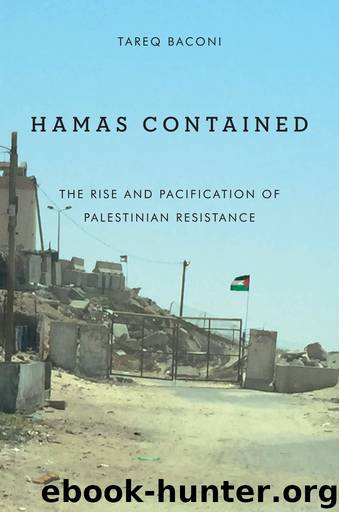Hamas Contained by Baconi Tareq

Author:Baconi, Tareq [Baconi, Tareq]
Language: eng
Format: epub
ISBN: 9781503605817
Publisher: Stanford University Press
Published: 2018-01-15T07:00:00+00:00
CONCLUSION
CONTAINMENT AND PACIFICATION
In 2015, the United Nations issued a report asserting that by the year 2020 the Gaza Strip would be uninhabitable if the situation that had prevailed since the blockade was instituted in 2007 persisted.1 With strong population growth, tightly controlled access of people and goods, and intermittent large-scale and immensely destructive and lethal military incursions by Israel, the Gaza Strip was deemed to be approaching the point of collapse. The report failed to compel members of the international community to take concerted measures to address this reality. In early 2017, Gaza suffered another humanitarian crisis, precipitated directly by the blockade, which remained administered by both Israel and Egypt. The strip’s two million inhabitants were receiving two to three hours of electricity per day, down from about four hours which they had been receiving since 2014. Hospitals were operating on emergency generators, the risk being that life-saving equipment could falter; sewage was being pumped into the Mediterranean as treatment plants were no longer operational; and drinking water and medical supplies were facing a severe shortage. International organizations declared Gaza on the brink of “total collapse.”2 The estimates first put forward by the UN report were revised, and they noted that the Gaza Strip could reach the point of being unfit for human life sooner than the initial estimate of 2020.3 It was the onset of an expansive military assault, weeks after the Shati Agreement had been signed in the summer of 2014, that had accelerated Gaza’s swift deterioration.
OPERATION PROTECTIVE EDGE
In the first half of June 2014, after the Shati Agreement had been signed, Palestinian factions were hammering out the details of the Palestinian Authority’s administrative return to the Gaza Strip. Hamas was seeking to off-load its governing responsibilities, such as the salaries of its forty-thousand-strong civil service, as a result of the financial constraints it was facing. The blockade had finally achieved its alleged purpose of weakening Hamas’s government and making room for the Palestinian Authority to return to Gaza. Yet the Ramallah leadership was driving a tough bargain, as it was unwilling to assume responsibility for a greatly dilapidated and battered Gaza Strip, particularly without effective control of the enclave, given Hamas’s refusal to disarm.4 This was met with a great deal of resentment inside Gaza, where people believed President Abbas was using the issue of employee salaries as a scapegoat to pressure Hamas and avoid reconciliation.5 For his part, Abbas was dealing with the implications of Israel’s strident refusal to allow the passage of the unity government, which were likely to take the form of measures to isolate the Palestinian Authority and withhold tax and customs revenue collected on its behalf.
The delicate balance being managed between Hamas and the Palestinian Authority against Israeli obstructionism was upended on June 12. That evening, three Israeli teenagers who were returning from their religious schools in illegal settlements in the West Bank back into Israel were kidnapped. As pictures of the students blasted on TV screens around the world, Israel launched
Download
This site does not store any files on its server. We only index and link to content provided by other sites. Please contact the content providers to delete copyright contents if any and email us, we'll remove relevant links or contents immediately.
| Arms Control | Diplomacy |
| Security | Trades & Tariffs |
| Treaties | African |
| Asian | Australian & Oceanian |
| Canadian | Caribbean & Latin American |
| European | Middle Eastern |
| Russian & Former Soviet Union |
The Secret History by Donna Tartt(18157)
The Social Justice Warrior Handbook by Lisa De Pasquale(11951)
Thirteen Reasons Why by Jay Asher(8451)
This Is How You Lose Her by Junot Diaz(6435)
Weapons of Math Destruction by Cathy O'Neil(5829)
Zero to One by Peter Thiel(5488)
Beartown by Fredrik Backman(5353)
The Myth of the Strong Leader by Archie Brown(5237)
The Fire Next Time by James Baldwin(5016)
How Democracies Die by Steven Levitsky & Daniel Ziblatt(4953)
Promise Me, Dad by Joe Biden(4908)
Stone's Rules by Roger Stone(4857)
100 Deadly Skills by Clint Emerson(4690)
A Higher Loyalty: Truth, Lies, and Leadership by James Comey(4550)
Rise and Kill First by Ronen Bergman(4545)
Secrecy World by Jake Bernstein(4388)
The David Icke Guide to the Global Conspiracy (and how to end it) by David Icke(4379)
The Farm by Tom Rob Smith(4323)
The Doomsday Machine by Daniel Ellsberg(4245)
